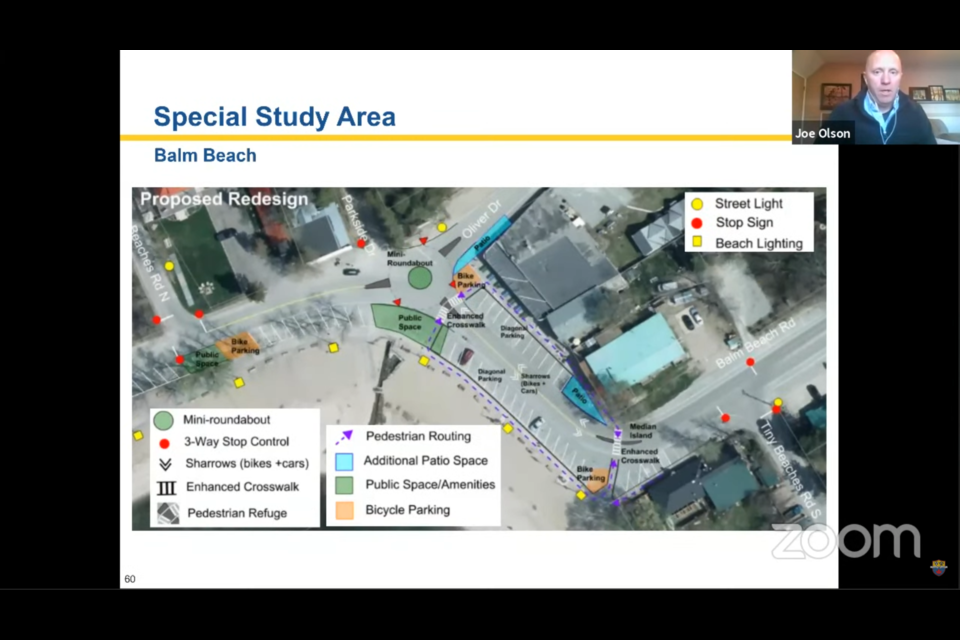The wheels are on the road for the next 10 years, and Tiny Township is asking the public for a push to get moving forward.
A draft for Tiny’s first transportation master plan (TMP) was presented to the committee of the whole recently, loaded with data and suggestions including: traffic calming on Tiny Beaches Road North and South as well as Balm Beach Road; converting most concession roads into ‘township collector’ roads; and a look at redesigning Balm Beach’s main hub to be more friendly to traffic, cyclists and pedestrians.
Tim Leitch, director of public works, stressed that what TMP developers Stantec Engineering Inc. were bringing forward was the high-level overview of an almost 400-page report that looked at public surveys and collected data over the past two years.
“I encourage people to look at the full presentation,” advised Leitch. “I thought this was very well done. It hit a lot of the marks that the public was looking for.”
Following public input, Stantec found the main issues concerning Tiny residents were: safe cycling routes; safety improvements for pedestrians on Tiny Beaches Road; accessibility improvements to beaches and waterfront; upgrades to the most prominent Tiny roads; speeding and traffic calming measures; and street parking improvements.
Top barriers preventing active transportation use were commented on as traffic speeds and safety, and not enough bicycle facilities, sidewalks or trails.
Traffic volumes were higher during summer more than other months, on weekends more than weekdays, and in afternoons and evenings rather than mornings.
Joe Olson, sustainable transportation project engineer, told council that up to 1,000 vehicles per day could be reduced if the TMP target measures were achieved by 2030.
“If we look at the trips that are short, so just under five kilometres,” said Olson, “we can see that there’s a lot of cycling and pedestrian activity going on. There’s about 11 per cent within that five-kilometre trip length, and this is the area we want to focus on because we can definitely influence behaviour here with some well-placed infrastructure.”
Aside from Simcoe County owned roads, Tiny Township consists of over 400 square kilometres although with only two road classification systems of local roads and arterial roads. The TMP suggests adding a new road classification, ‘township collector road,' which would effectively change the bulk of concessions and major non-county roads into collectors.
Doing so would open up opportunities to develop the routes to accommodate cycling traffic and traffic calming measures. Additionally, a network of cycling paths and trails throughout the township would provide north-south and east-west connectivity to neighbouring municipalities.
Truck routes would be more clearly defined for efficient flow of goods, and arterial roads such as County Road 6 would remain as is.
Balm Beach was looked at as a “problematic area,” with a suggested redesign to include a mini-roundabout as a pedestrian refuge, a three-way stop at Balm Beach Road and Tiny Beaches Road South for equal turn opportunity, angled parking, and painted sharrows (shared lane markings) for cyclists.
“We’re proposing, at a concept level, some things that can be done to organize the area a little bit better for all users,” offered Olson.
The proposed cost of the TMP in the design stage could go as high as $10-million, with nearly all of that focused on regional bike infrastructure.
“The $7-million to $10-million for the bike facilities really comes out of the fact that there’s 120 kilometres of bike lane if you were to implement that active transportation map,” Olson explained, adding uncertainty of shoulder conditions and base gravel to pave upon as unknown factors.
“This is looking at decades, I would presume, to do that whole network. What we’re suggesting to do in the short term is to focus on Balm Beach Road and Tiny Beaches Road. Let’s start there, then we can start looking at some future concession roads,” said Olson.
High level costs of short term recommendations were suggested, calculated as roughly $1-million over several projects such as the Balm Beach area improvements, speed calming measures, and instituting enhanced crosswalks at Concession 9 and Tiny Beaches Road South as an example.
Coun. John Bryant had particular interest in Tiny Beaches Road, aiming many questions at preserving its unique character, culture and quirkiness within the suggested redesigns. He asked if perhaps there could be a road classification lower than township local, but was informed by Leitch that it was at the lowest traffic designation already.
“Tiny Beaches road is unique, but it is a road,” reminded Leitch. “The vast majority of people have spoken that they want more speed controls on the road, more active transportation, more accessibility. The TMP has spoken, and that’s through all of our surveys.”
Coun. Cindy Hastings perked up as a suggestion was made to pave the gravel base of the Rail Trail for accessibility purposes, asking if horse usage and wintertime snowmobiles were considered.
The question surprised Olson who admitted users of the trails other than pedestrians and cyclists weren’t considered on the high-level examination of data. Leitch took the opportunity to remind council and the public to provide input on the project, and that it was details like these that were being sought in the process.
“Keep the questions coming. Keep the information moving our way so we can build a good, solid plan,” requested Leitch.
Information on the project will be updated on the Tiny Transportation Master Plan page of the township website.
The public works report and related TMP presentation by Stantec can be found as part of the agenda through the township website.
Archives of council meetings are available to view on Tiny Township’s YouTube channel.



